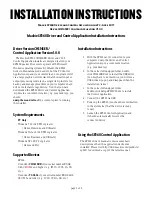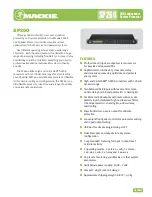
6: Basic Parameters
SLC™ Console Manager User Guide
66
2.
Enter the following:
Enable VPN Tunnel
Select to create a tunnel.
Name
The name assigned to the tunnel. Required to create a tunnel.
Ethernet Port
Select ethernet port 1 or 2.
Remote Host
The IP address of the remote host's public network interface. The special
value of
any
can be entered if the remote host is a roaming user who may
not have the same IP address each time a tunnel is created. In this case, it
is recommended that the
Remote Id
also be configured.
Remote Id
How the remote host should be identified for authentication. The Id is used
to select the proper credentials for communicating with the remote host.
Remote Hop/Router
If the remote host is behind a gateway, this specifies the IP address of the
gateway's public network interface.
Remote Subnet(s)
One or more subnets behind the remote host, expressed in CIDR notation
(IP address/mask bits). If multiple subnets are specified, the subnets should
be separated by a comma.
Local Id
How the SLC console manager should be identified for authentication. The
Id is used by the remote host to select the proper credentials for
communicating with the SLC device.
Local Hop/
Router
If the SLC console manager is behind a gateway, this specifies the IP
address of the gateway's public network interface.
Local Subnet(s)
One or more subnets behind the SLC unit, expressed in CIDR notation (IP
address/mask bits). If multiple subnets are specified, the subnets should be
separated by a comma.
IKE Negotiation
The Internet Key Exchange (IKE) protocol is used to exchange security
options between two hosts who want to communicate via IPSec. The first
phase of the protocol authenticates the two hosts to each other and
establishes the Internet Security Association Key Management Protocol
Security Association (ISAKMP SA). The second phase of the protocol
establishes the cryptographic parameters for protecting the data passed
through the tunnel, which is the IPSec Security Association (IPSec SA). The
IPSec SA can periodically be renegotiated to ensure security. The IKE
protocol can use one of two modes: Main Mode, which provides identity
protection and takes longer, or Aggressive Mode, which provides no identity
protection but is quicker. With Aggressive Mode, there is no negotiation of
which cryptographic parameters will be used; each side must give the
correct cryptographic parameters in the initial package of the exchange,
otherwise the exchange will fail. If Aggressive Mode is used, the
IKE
Encryption
,
IKE Authentication
, and
IKE DH Group
must be specified.
IKE Encryption
The type of encryption,
3DES
or
AES
, used for IKE negotiation.
Any
can be
selected if the two sides can negotiate which type of encryption to use.
Authentication
(Ike)
The type of authentication,
SHA1
or
MD5
, used for IKE negotiation.
Any
can be selected if the two sides can negotiate which type of authentication
to use.
DH Group
(Ike)
The Diffie-Hellman Group,
2
or
5
, used for IKE negotiation.
Any
can be
selected if the two sides can negotiate which Diffie-Hellman Group to use.
ESP Encryption
The type of encryption,
3DES
or
AES
, used for encrypting the data sent
through the tunnel.
Any
can be selected if the two sides can negotiate
which type of encryption to use.
Authentication
(Ike)
The type of authentication,
SHA1
or
MD5
, used for authenticating data sent
through the tunnel.
Any
can be selected if the two sides can negotiate
which type of authentication to use.
















































